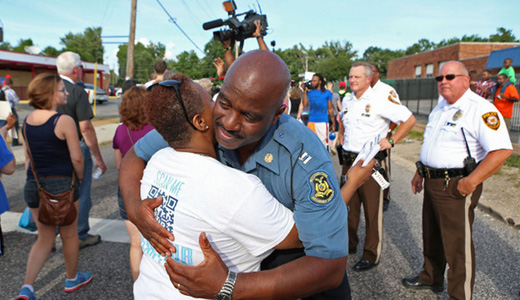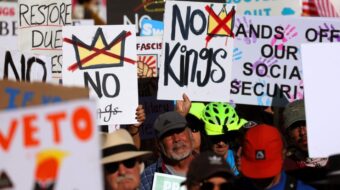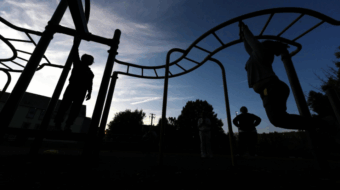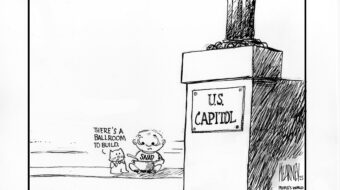
Tens of thousands gathered in cities across the country Thursday night in remembrance of Michael Brown, the 18-year-old African-American teen shot to death by a Ferguson policeman. And they gathered to protest the military-style violence by police against peaceful demonstrators in that town.
A national moment of silence was observed in St. Louis, under the famous arch, in Times Square and Union Square in New York City, in Boston, in Charlotte, North Carolina and in as many as 100 other cities. Everywhere the message was the same: There is no excuse in the United States of America for rifles and heavy weaponry to be aimed at people exercising their right to peaceful protest.
As they marched in towns across the country they held up their hands and chanted, “Hands up, don’t shoot,” the last words Brown is reported to have said before as many as eight bullets were pumped into his back, causing him to collapse dead on the street.
President Obama had said earlier in the day that there was no excuse for harassing and arresting people who are exercising their right to peaceful protest. He also said during an announcement at Martha’s Vineyard, that he had ordered the Justice Department and the FBI to investigate Brown’s death.
The outpouring of national support for the people of Ferguson was prompted in part by the horrific images of camouflage-wearing cops wielding high-powered rifles that went out all over the world on television and the Internet.
In Ferguson itself the national outcry resulted in the Missouri police radically changing their tactics. Gone Thursday night was the military weaponry, the SWAT teams, the high-powered rifles, and even most of the police officers themselves. The St. Louis County police were replaced by the state’s Highway Patrol – under the orders of Gov. Jay Nixon.
The protest demonstrations last night, which were the largest so far in Ferguson, went off completely peacefully.
After four nights of heavy-handed military style policing, a relaxed atmosphere replaced the war zone atmosphere of the previous nights.
Missouri Highway patrol Captain Ronald Johnson walked through the crowds, at one point apologizing for the behavior of police who had attacked and tear-gassed people the night before. He said the Highway Patrol police would continue a more respectful tone with protesters.
On Friday a six-year veteran of the Ferguson police force, Darren Wilson, was identified as the policeman who killed the unarmed Black teenager, touching off the protests and the heavy-handed military style police response.
The release today of the name of the policeman who did the shooting meets one of the major demands demonstrators were making last night, as they had for several days before.
The police also said, when they made that announcement, that Brown was a suspect in a convenience store robbery. They allege that he took a box of candy swisher cigars.
Police said that the officer who filled out an incident report when he saw Brown’s body in the street, four hours after he was shot, had compared what he saw there with video surveillance tape from the convenience store.
The community in Ferguson is at the very least skeptical about the release of these tapes four days after the killing. Brown’s family, through their attorney on Friday, urged that protests continue but that they remain peaceful. The release of the tapes, they said, is an attempt to besmirch the victim’s character and that it in no way changes the basic facts: Michael Brown was shot to death with his hands up in the universal sign of surrender and law enforcement then mounted an unwarrented miltary-style attack on the entire community.
Brown’s friend, Dorian Johnson, was with Brown the night he was shot. He told the press that the officer pulled alongside them as they were walking down the street. The officer tried to thrust his car door open but the door slammed into Brown and bounced back closed. He said the officer then grabbed Brown by the neck, pointed the gun at him and said, “I’ll shoot.”
Johnson said the officer fired shots after Brown turned his hands up and said, “I don’t have a gun, stop shooting.”
In Ferguson Thursday night, among the racially mixed crowds of protesters, were people pushing carriages with children. One such couple held a sign that read, “We are the village.”
It was just one of many scenes from Thursday night’s peaceful protests that went out around the world showing how the change in police tactics resulted in an immediate change in the atmosphere over Ferguson.
Democratic State Sen. Maria Chappelle-Nadal was in the crowd. She told MSNBC News that she hoped the positive images of serious African-American youth, marching for peace in their communities, would go out and be remembered across the country.
A variety of issues surfaced as people in the streets talked openly and freely to the press about many of the concerns they have with the way in which local affairs are run.
Many complained for example, how towns like Ferguson and nearby Moline use fines collected after traffic stops as a major source of income. African Americans, they said, are stopped most frequently and fined heavily for minor offenses. When the offenses go on the permanent records of the people, they said, they can never be considered as hires for the police or other departments.
Ferguson is a mostly African-American town with an almost entirely white police force.
Patricia Bynes, an African-American Democratic County committeewoman, said she believed the peaceful protests would help empower people. She told MSNBC last night that she would work to increase voter turnout among her constituents. And that if that happens, she noted, it would help solve the imbalance-between the largely African-American town and its largely white government.
Photo: Captain Ronald Johnson of the Missouri highway patrol hugs Angela Whitman from Berkeley, Missouri, in Ferguson on August 14. David Carson/St. Louis Post-Dispatch/AP










